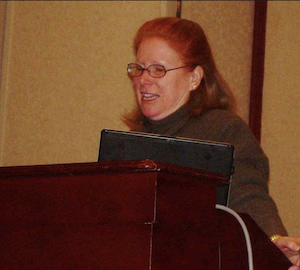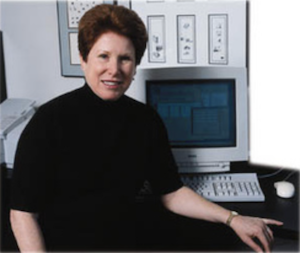
Adele Goldberg was born on July 22, 1945, in Cleveland, Ohio. Her family lived in Ohio until Goldberg turned seven years old and her family moved to Chicago. Her mother’s name was Lillian Goldberg, secretary at a high school, and her father’s name was Morris Goldber, an industrial engineer. Goldberg is a twin along with an older sister; however, she was more fascinated by STEM than her siblings. Goldberg had different hobbies and interests than her two other sisters. For instance, at a young age, she had an interest in science but was more deeply interested in mathematics. Her parents were very hopeful for her career and never stopped her from doing anything she loved. She attended the University of Michigan, where she majored in mathematics. From her experiences and classes there, she considered computer science as a career. Subsequently, she immediately sought jobs at International Business Machines Corporation over her junior and senior year summers. During her summer break, Goldberg taught herself program applications, such as record machines. Goldberg later continued her academic career by pursuing a Ph.D. from the University of Chicago in information science in 1973.
After the completion of her academics in the 1970s, Goldberg took on the role of a researcher at Xerox’s Palo Alto Research Center. This is where Goldberg, along with her research team, developed SmallTalk – the language that changed how programmers view computer science. It allowed developers to understand the world of technology in a more optimized and efficient way. It paved the pathway for future programming languages to come. She collaborated with Alan Kay, an American computer scientist, during the 1970s and 1980s to develop an object-oriented programming language system known as SmallTalk. SmallTalk revolutionized computer science tremendously, as it brought groundbreaking logical reasoning and theoretical topics that were new to society. It was used to create the world’s first modern graphical user interfaces with icons, windows, menus, and tools. Goldberg was a team manager and led her research group during her time at Xerox.

However, after her project was complete, Goldberg faced a conflict with the Founder of Apple, Steve Jobs. Jobs visited the Palo Alto Research Center in 1979 because he was fascinated with the team’s project with SmallTalk. However, Adele strongly resisted showcasing Jobs the SmallTalk interface because she wanted to avoid fraud and duplications of her team’s innovative technology. Unfortunately, her decision to refuse to show the interface was overturned by the senior management of the research center. Goldberg then reluctantly had to share her records and documentation of SmallTalk with Jobs and his team. She later reflected on how her contribution has made an incredible impact on Apple’s machinery and design. Smalltalk brought in the idea of graphical user interfaces and user experience, heavily influencing the development of Apple.
Goldberg wanted to educate others about SmallTalk, taking on a leadership role and founding ParcPlace Systems. In this company, Goldberg was the CEO and chairman andWithin the company, tools and web-based applications were created to further expand SmallTalk. These accomplishments have made an influential impact on the technology industry, creating new programs, applications, software, and websites. During an interview, Goldberg recalls how during the ‘80s, people faced user-interface design issues and conflicts. For example, text fields and menu tools were poorly functioning. Therefore, Goldberg wanted to change how users view applications and programs since changing the functions in applications would have a huge benefit on society. Thus, Goldberg took the initiative to make an impact. Without Goldberg’s interest and passion for computer science, SmallTalk would have never been created.

Along with Goldberg’s achievements, she has received numerous awards. Goldberg was the president of the company known as the Association of Computer Machinery from 1984 to 1986. With Goldberg’s great intelligence, she won the Association of Computer Machinery Software Systems Award along with her co-creators Alan Kay and Dan Ingalls. It empowered her and brought her research and her work in Smalltalk to significant recognition. Another award that Goldberg received was PC Magazine's Lifetime Achievement Award, given to individuals who have made remarkable contributions to a specific industry during 1990. With Goldberg’s strength, determination, and passion for computer science, she continues to teach others. Goldberg wants to adjust the gender gap in modern technology and continues to pursue her interest in teaching and education by creating computer science courses at community colleges across the United States and beyond. She aims to educate women in the computer science field and empower others to pursue STEM-based fields. Indeed, with Goldberg’s qualities of motivation and determination, she has affected technology across the globe, which has made a meaningful impact.
Why Did I Choose to Research Adele Goldberg?
I chose Adele Goldberg to research because her backstory and her contributions to the technological society inspired me. Through my research of Goldberg’s motivational story, I hope many will be able to gain pieces of advice along with wisdom. I hope that others will learn about Goldberg’s backstory and how motivational she is in how she approached the gender gap in STEM. As a female passionate in computer science and STEM myself, I was able to gain new knowledge about the industry. For instance, I was able to learn that Adele Goldberg co-created the first-ever object-oriented programming language known as SmallTalk leading to the creation of Java, an object-oriented language. Without Goldberg’s work, such significant languages would have not been created. As someone who enjoys coding various applications and programs, I found it intriguing to research about Adele Goldberg. Through my applications and projects, I can create my very own websites and programs. To conclude, through Goldberg’s story, a story of one of the most influential computer scientists and has made a tremendous impact on computer science in the modern world.
Works Cited
Adele Goldberg Summary. (n.d.). Www.BookRags.Com. http://www.bookrags.com/biography/adele-goldberg-wcs/#gsc.tab=0
Dr. Adele Goldberg, Vice-Chair. (2019, June 6). HITS GGmbH. https://www.h-its.org/people/about-adele-goldberg/
Goldberg, A. (n.d.). Adele Goldberg - Computing History. The Centre for Computing History. Retrieved November 19, 2022, from http://www.computinghistory.org.uk/det/47368/Adele-Goldberg/
Oral-History:Adele Goldberg - Engineering and Technology History Wiki (2021). Oral-History: Adele Goldberg. https://ethw.org/Oral-History:Adele_Goldberg
Qamar, T. (2022, March 22). Adele Goldberg - The Inspiration Behind The First Apple Computer — Odetta Odetta. Retrieved November 19, 2022, from https://odetta.ai/blogs/adele-goldberg-the-inspiration-behind-the-first-apple-computer
WITI - Adele Goldberg. (2010). Adele Goldberg. https://www.witi.com/halloffame/100883/Adele-Goldberg-Founding-Chairman-ParcPlace-Systems,-Inc/#:%7E:text=She%20received%20the%20ACM%20Software,the%20Association%20for%20Computing%20Machinery
... (2019, January 17). ... - YouTube. Retrieved November 19, 2022, from https://spectrum.ieee.org/qa-adele-goldberg-on-the-legacy-of-smalltalk
This article was published on 3/13/24